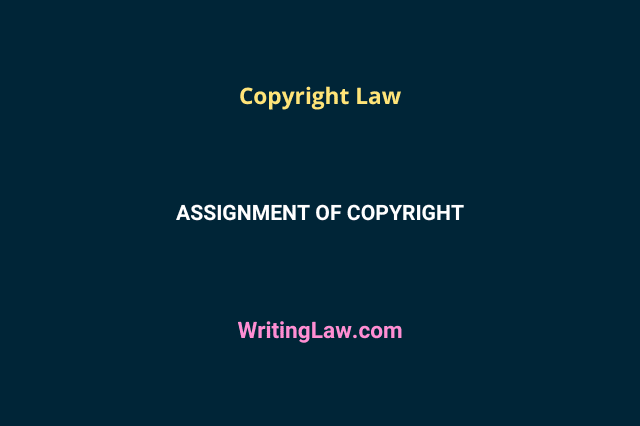
Original work may not be reproduced, distributed, or sold by anybody other than the copyright owner without that owner’s consent. As a result, the law allows the copyright owner to assign ownership to a third party.
The term “copyright assignment” describes the transfer of ownership or rights in a work that has been granted copyright from the original copyright holder (the “assignor“) to a different party (the “assignee“). Through a legal procedure, the assignor gives up their ownership of the work and gives the assignee the only authority to reproduce, distribute, display, perform, or alter it.
This article discusses the concept of copyright assignment, which involves the transfer of ownership or rights in a copyrighted work from the original copyright holder (assignor) to another party (assignee). The article also explains the various aspects of copyright assignment, including its mode of assignment and disputes with respect to the assignment of copyright.
Assignment of Copyright
(Section 18 of the Copyright Act, 1957)
The owner of the current work or the potential owner of the future work may assign the copyright. It may be fully or partially allocated. Limitations may apply to all or a portion of the copyright.
Additionally, if future work is assigned, the assignment will become effective when the new work is created. In future works, “assignee” includes the assignee’s legal representative if they die before the work is created.
The court ruled in Saregama India Ltd. vs Suresh Jindal And Ors. that the copyright owner to a future work has the right to assign the copyright, in whole or in part, to a third party. This indicates that the owner may assign the copyright ownership for the entire term or only a portion.
The assignee is regarded as the legal owner of the copyright after the assignment is made, and the Copyright Act recognises all associated rights and benefits. As mentioned above, the ruling affirms that copyright ownership can be transferred by assignment, enabling people or organisations to obtain and exercise control over the rights connected to the copyrighted work.
Mode of Assignment of Copyright
(Section 19 of the Copyright Act, 1957)
Every assignment of the copyright to a work must be made in writing and be signed by the assignor or an authorised representative. Only that assignment will be accepted. Any assigned work must include all relevant information, including the assignment, length, rights, and geographic scope.
The amount of any royalties or other payments made to the author or his legal heirs during the assignment should also be specified. Any revisions, extensions, or terminations of the assignment are subject to the mutually agreed-upon terms and circumstances.
Let’s say the assignee fails to utilise the right granted during the assignment within a year of receiving it. If such a thing occurs, the assignment of those rights will be presumed to have terminated unless otherwise specified in the assignment. When the assignment time and geographical scope are not specified, they will be assumed to be five years from the date of the assignment and inside India, respectively.
The Bombay High Court considered whether the assignment of video rights included the right of satellite transmission in the case of Video Master vs Nishi Production. The court accepted the defendant’s claim that several public communication channels, such as satellite broadcasting, video TV, and terrestrial television broadcasting, each constituted a distinct copyright.
As a result, the film’s owner may transfer these rights to other people or companies. The court concluded that the video copyright granted to the plaintiff was separate from the copyright for the satellite transmission of the movie. Consequently, the satellite broadcast right was not part of the assignment.
Disputes With Respect to the Assignment of Copyright
(Section 19A of the Copyright Act, 1957)
After receiving a complaint from the assignor and completing an investigation, the appellate board has the authority to revoke the assignment or issue any orders it sees suitable when the assignee fails to execute the powers granted to him if such failure is not a result of any action or inaction on the part of the assignor.
If the assignor is also the author, the appellate board should hold off on issuing any revocation unless it is established that the terms of the assignment are harsh to the assignor. Additionally, no revocation may be made for five years if an assignment has been made.
The appellate board should handle copyright assignment complaints promptly and with diligence. They have a time limit of six months from the date of receiving the complaint to reach a final decision. If, for any reason, there is a delay beyond this period, the appellate board must explain the reasons for the delay. The goal is to ensure that copyright disputes are resolved promptly and transparently.
Conclusion
In this evolving world, copyright assignment is an unavoidable need. People are not always able to rely on themselves. The ownership of the work must be transferred to properly frame the art and realise the original piece’s full creative potential.
Furthermore, copyright assignment aids in the seamless development of the creative process when several creative minds collaborate or when a work is adapted across various media. It allows for fresh viewpoints, interpretations, and variations that could improve the original work or investigate other creative paths.
Read Next: Doctrine of Merger Under Copyright Law
- What Is Misappropriation of Trade Secrets and Its Defences? - 15th May 2024
- 7 Important Types of Mediation Briefly Defined - 14th May 2024
- Whirlpool India vs Videocon Industries – Case Explained - 13th May 2024







